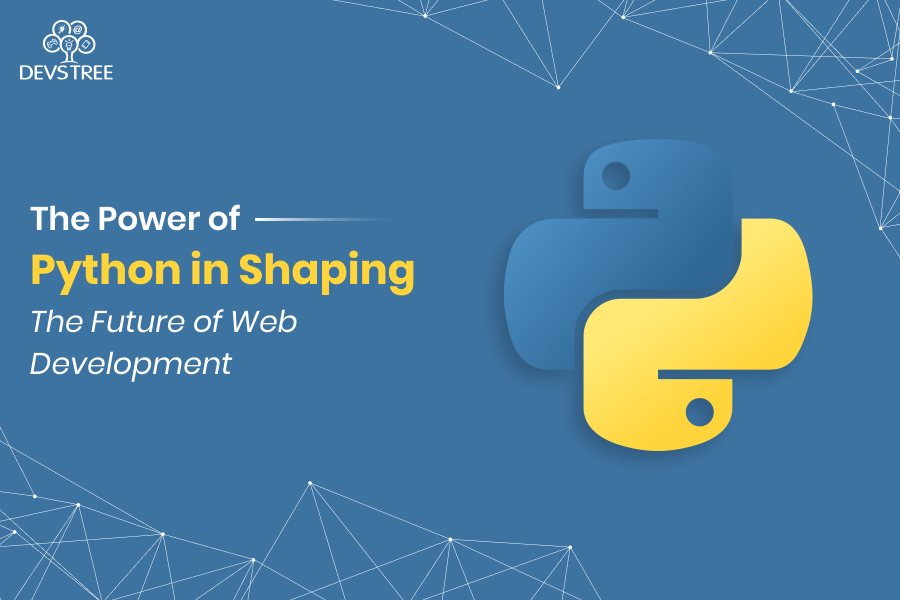- December 20, 2023
- by devstree
- Web Development
- 1424 Views
- 0 Comments
In the dynamic realm of web development, Python emerges as a key player, shaping the landscape of futuristic technology. As we embark on this digital journey, the language’s versatile capabilities and extensive contributions propel it to the forefront of innovation. Python isn’t just a computer language; it’s like a super tool that developers all around the world use to make cool stuff on the internet.
This introduction gets us ready to learn about all the different things Python can do when making websites and online things. From its versatile syntax to a plethora of frameworks and libraries, Python’s influence extends beyond mere code—it permeates the very essence of the technology that powers our interconnected digital experiences. Let’s dive into the details, uncovering how Python seamlessly integrates into server-side scripting, client-side development, and various other facets, leaving an indelible mark on the ever-evolving landscape of web technology.
A Versatile Language
Python’s versatility, evident in its clean and readable syntax, not only caters to beginners but also enables developers to effortlessly transition between different facets of web development, making it an ideal language for diverse projects. Its widespread community support and rich ecosystem further contribute to its standing as a go-to choice for a wide range of applications.
Role in Server-Side Scripting
In server-side scripting, Python shines with its powerful web frameworks designed for specific development needs. Let’s check out three major frameworks that have shaped the server-side scripting scene:
Django
Django, a high-level web framework, goes beyond being just a tool; it’s a philosophy for achieving perfection in server-side scripting. With an emphasis on DRY (Don’t Repeat Yourself) and convention over configuration, Django streamlines development, offering a robust ORM system, authentication mechanisms, and an admin interface out of the box.
Flask
Flask, a micro-framework, is an embodiment of simplicity and flexibility. Its minimalistic approach allows developers to build web applications tailored to their specific needs. It’s an excellent choice for smaller projects or when a more lightweight framework is preferred.
Pyramid
Pyramid strikes a balance between Django’s feature richness and Flask’s simplicity. Its modular architecture and extensive documentation make it adaptable for projects of varying scales. Developers appreciate the freedom Pyramid provides in choosing components, making it a versatile option.
Role in Client-Side Development
Python is not limited to server-side scripting; it extends its influence to client-side development, showcasing its prowess in various domains.
Data Visualization with Python
Libraries such as Matplotlib, Seaborn, and Plotly empower developers to create visually compelling data representations. Integration with Jupyter notebooks facilitates data exploration, analysis, and sharing in a seamless and interactive manner.
Web Scraping and Automation
Python’s libraries, like BeautifulSoup and Scrapy, simplify the extraction of data from websites. This capability is not limited to data collection but extends to tasks like content aggregation, providing a powerful toolset for automation in web-related processes.
Machine Learning and AI Integration
Python’s dominance in the machine learning and AI domains is evident through libraries like TensorFlow and PyTorch. This integration allows developers to introduce intelligent features, predictive analytics, and personalized user experiences into their web applications.
Content Management Systems (CMS)
Python-based CMS platforms, such as Wagtail, offer a user-friendly experience for both content creators and developers. The flexibility of these systems ensures the efficient management and delivery of dynamic and scalable web content.
Web Design Tools and Libraries
Python provides a diverse set of tools and libraries to assist web designers in crafting visually appealing and responsive web interfaces.
Bootstrap
Bootstrap, a popular front-end framework, seamlessly integrates into Python projects. By providing pre-designed CSS and JavaScript components, Bootstrap simplifies web page development, making it easy to create visually appealing and responsive interfaces.
Jinja2
Jinja2, a templating engine, facilitates the creation of dynamic web pages. Its syntax is intuitive, making it easy for developers to integrate dynamic content seamlessly into their web applications.
Pillow
For image processing, the Pillow library provides a robust set of tools. From resizing and cropping to applying filters, Python developers can enhance the user experience by manipulating images efficiently.
CSS Preprocessors
Python developers can utilize CSS preprocessors like Sass and Less to improve the maintainability and modularity of stylesheets. These preprocessors introduce features like variables, nesting, and mixins, streamlining the styling process.
Automation Testing and Quality Assurance
Python’s simplicity and readability extend into the realm of automation testing. Frameworks like Selenium, Pytest, and Robot Framework empower developers to create comprehensive test suites. This ensures the quality and reliability of web applications, contributing to a robust development and deployment process.
Summing Up
In summary, Python’s impact on web development is extensive and influential. It plays a pivotal role in both server-side scripting and client-side development, seamlessly integrating tasks from data visualization to machine learning. Python’s enduring presence in shaping the future of web technology is characterized by its versatility, supported by a vibrant community, and underlined by comprehensive documentation. As we anticipate the future, Python’s influence is poised to expand further, leaving a lasting imprint on the ever-evolving field of web development.

